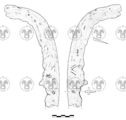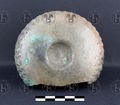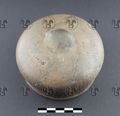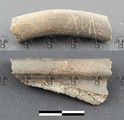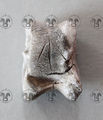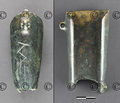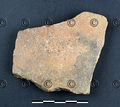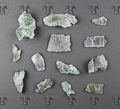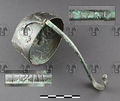Non-script notational systems
Preliminaries
The Raetic corpus at it presents itself today contains a considerable number of "inscriptions" which can fairly certainly be determined to not represent writing in the linguistical sense (i.e., reflecting linguistic units). The vast majority of these, however, must be expected to have a para-linguistic meaning, and should not be disregarded. This page collects 1. the relevant material from the TIR corpus, 2. inscriptions which have been included in other editions of Raetic inscriptions, but not in TIR, and 3. various documents which are mentioned in the older or archaeological literature or were found by the project team in repositories. To facilitate reference to the documents in groups 2 and 3, we have attempted a preliminary organisation of the material by assigning the sigla code EX (for "excluded" from the corpus), regardless of provenance, followed by a consecutive reference number. An introduction presenting options for classification and interpretation of the material will follow in time. See, in the meantime, Kluge 2017. (Punctuation marks as integral elements of the writing system proper are discussed on Script.)
Para-script in the Raetic corpus
Delimitation signs
A number of (arguably) language-encoding inscriptions feature in final position a character or mark which, though sometimes in the shape of a letter, can be demonstrated (or argued) to be a delimiter, i.e. marking the end of a text.
- NO-6 and SZ-40 appear to be delimited by a mark
 (oblique strokes in SZ-40), though is is not sure that the fragmentary NO-6 does not go on after the mark. Cp. VN-7.1.
(oblique strokes in SZ-40), though is is not sure that the fragmentary NO-6 does not go on after the mark. Cp. VN-7.1. - A mark
 appears in final position in NO-7 and CE-1.5. In both cases, the interpretation of the inscription strongly suggests that
appears in final position in NO-7 and CE-1.5. In both cases, the interpretation of the inscription strongly suggests that  is to be read not as a letter Theta, but as a delimiter.
is to be read not as a letter Theta, but as a delimiter.
Preliminary list of (suspected) para-script material included in the Raetic corpus
- potential factory marks on rims and handles of metal vessels: BZ-7.1, BZ-7.2, BZ-8.1, BZ-8.2, NO-8, SZ-18, SZ-35, SZ-36, SZ-37.1, SZ-37.2, SZ-75, SZ-82
- potential factory marks on iron implements:
- (including) symbols / ornament (?): BZ-19, SZ-25, SZ-26 (?), SZ-78, SZ-80
- on scythe rings and related: SZ-44.1, SZ-44.2, SZ-45.1, SZ-45.2, SZ-46.1, SZ-46.2; SZ-47, SZ-72 (different groups); SZ-50, SZ-51 (tools)
- on the side of axe heads: SZ-62, SZ-76.1, SZ-76.2, SZ-77, SZ-81
- letter: SZ-33, SZ-74 (þine), SZ-43.1, SZ-43.2, SZ-79.1, SZ-79.2 (uli)
- on bronze implements: HU-1; SZ-65.1, SZ-65.2 (ku)
- on statuettes: SZ-20, SZ-71
- on bone/antler: BZ-15, SZ-48, SZ-49, SZ-63
- on pottery: BZ-20, BZ-21, BZ-22, BZ-23, SZ-55, SZ-69, SZ-83, NO-14, WE-7 (θr)
- on ciottoloni: IT-6, SR-11
- on loom weights: PU-2, PU-3, (MA-24)
Para-script in Raetic context
Complete list of objects with marks filed with an EX(cluded)-siglum in TIR
| Siglum and object type | Find place | Repository and inv. no. | Reference | see below |
|---|---|---|---|---|
| EX-1 knife | Sanzeno | Tiroler Landesmuseum Ferdinandeum 12.578 | LIR SA-96; Nothdurfter 1979: no. 300 | Dubious cases |
| EX-2 hoe | Sanzeno | Tiroler Landesmuseum Ferdinandeum 12.571 | LIR SA-109; Nothdurfter 1979: no. 340; MLR 227 | Sanzeno I |
| EX-3 knife | Sanzeno | Tiroler Landesmuseum Ferdinandeum 12.302 | LIR SA-104; Nothdurfter 1979: no. 295; MLR 233 | Sanzeno I |
| EX-4 axe | Sanzeno | Tiroler Landesmuseum Ferdinandeum 12.580 | LIR SA-105; Nothdurfter 1979: no. 199; MLR 191 | Sanzeno I |
| EX-5 spear butt | Sanzeno | Tiroler Landesmuseum Ferdinandeum 12.390 | LIR SA-106; Nothdurfter 1979: no. 1247 | Sanzeno I |
| EX-6 chisel | Sanzeno | Tiroler Landesmuseum Ferdinandeum 12.453 | LIR SA-112; Nothdurfter 1979: no. 154; MLR 224 | Sanzeno I |
| EX-7 fragment (bronze vessel) | Sanzeno | Tiroler Landesmuseum Ferdinandeum 13.225a | LIR SA-83; MLR 184 | Dubious cases |
| EX-8 handle (bronze vessel) | Sanzeno | Tiroler Landesmuseum Ferdinandeum 13.475 | LIR SA-94 | Dubious cases |
| EX-9 gouge | Sanzeno | Tiroler Landesmuseum Ferdinandeum 12.537 | LIR SA-111; Nothdurfter 1979: no. 143; MLR 223 | Sanzeno I |
| EX-10 chisel | Sanzeno | Tiroler Landesmuseum Ferdinandeum 12.418 | LIR SA-102; MLR 230 | Sanzeno I |
| EX-11 handle (bronze vessel) | Sanzeno | Tiroler Landesmuseum Ferdinandeum 12.871 | LIR SA-107; MLR 225 | Dubious cases |
| EX-12 hoe | Sanzeno | Tiroler Landesmuseum Ferdinandeum 12.541a | LIR SA-108; Nothdurfter 1979: no. 337; MLR 235 | Sanzeno I |
| EX-13 key | Sanzeno | Tiroler Landesmuseum Ferdinandeum 12.354a | Nothdurfter 1979: no. 834; Bassi 1996: 87 [Scheda N. II.2], fig. 24.2 | — |
| EX-14 knife | Sanzeno | Tiroler Landesmuseum Ferdinandeum 3.487 | LIR NO-2 | Dubious cases |
| EX-15 potsherd | Ganglegg | Vintschger Museum (no inv. no.) | Gamper & Steiner 1999: fig. 24.12; Steiner & Gamper 1999: fig. 10.6 | — |
| EX-16 bone point | Ganglegg | Vintschger Museum G 2001.109 | ? | Ganglegg |
| EX-17 bone point | Ganglegg | Vintschger Museum G 2001.209 | Gamper 2006: fig. 63.12 | Ganglegg |
| EX-18 bone point | Ganglegg | Vintschger Museum G 97.274 | Gamper 2006: fig. 87.7 | Ganglegg |
| EX-19 bone point | Ganglegg | Vintschger Museum G 2000.1030 | ? | Ganglegg |
| EX-20 bone | Ganglegg | Vintschger Museum G 2011.80 | unpublished | Ganglegg |
| EX-21 bone | Ganglegg | Vintschger Museum G 2011.83 | unpublished | Ganglegg |
| EX-22 bone | Ganglegg | Vintschger Museum G 97.263 | Gamper 2006: fig. 73.2 | Ganglegg |
| EX-23 bone point | Ganglegg | Vintschger Museum G 97.[???] | Gamper 2000: fig. 12.3; Gamper 2006: fig. 149.11 | Ganglegg |
| EX-24 bone point | Ganglegg | Vintschger Museum G [?] | Gamper 2006: fig. 69.4; MLR 262.4 | Ganglegg |
| EX-25 bone point | Ganglegg | Vintschger Museum G 2000.1070 | Steiner & Gamper 2001: fig. 6.3; Gamper 2006: fig. 69.3; MLR 262.3 | Ganglegg |
| EX-26 bone point | Ganglegg | Vintschger Museum G 2000.1031 | Steiner & Gamper 2001: fig. 6.6; Gamper 2006: fig. 69.2; MLR 262.2 | Ganglegg |
| EX-27 bone point | Ganglegg | Vintschger Museum G 2000.1063 | Gamper 2006: fig. 69.1; MLR 262.1 | Ganglegg |
| EX-28 handle (bronze vessel) | Ganglegg | Vintschger Museum W.P. 1155 | Gamper 2000: fig. 8.11 | — |
| EX-29 bowl | Ganglegg | Vintschger Museum (inv. no. unknown) | Gamper & Steiner 1999: fig. 24.11; Steiner & Gamper 1999: fig. 8.6; Gamper 2006: fig. 150.7 | — |
| EX-30 bone (astragalos) | Ganglegg | Vintschger Museum (inv. no. unknown) | Gamper 2006: fig. 69.25 | Marks on astragaloi |
| EX-31 axe | Piperbühel | Stadtmuseum Bozen / Museo Civico di Bolzano 530 | Menghin 1914: 7, fig. 6b | — |
| EX-32 axe | Kaltern / Caldaro | Castello del Buonconsiglio 2.788 | Orsi 1882: no. 4; MLR 19 | Marks on Hallstatt axes |
| EX-33 axe | Kaltern / Caldaro | Castello del Buonconsiglio 2.791 | Orsi 1882: no. 6; MLR 18 | Marks on Hallstatt axes |
| EX-34 axe | Kaltern / Caldaro | Castello del Buonconsiglio 2.792 | Orsi 1882: no. 7 | Marks on Hallstatt axes |
| EX-35 bone point | Sanzeno | Castello del Buonconsiglio 7.043 | Ghislanzoni 1931: 442, fig. 52, fig. 96h; MLR 187 | Ganglegg |
| EX-36 simpulum | Sanzeno | Castello del Buonconsiglio 6.983 | Ghislanzoni 1931: 432, fig. 30, fig. 96g; MLR 186 | — |
| EX-37 situla | Sanzeno | Castello del Buonconsiglio 8.155 | Fogolari 1960: 285 [no. 89] | — |
| EX-38 axe | Sanzeno | Castello del Buonconsiglio 2.836 | LIR: SA-110; Nothdurfter 1979: no. 181 | — |
| EX-39 axe | Sanzeno | Castello del Buonconsiglio 8.043 | Fogolari 1960: 276–277 [no. 89], pl. V.1 | — |
| EX-40 hoe | Castelfondo | Castello del Buonconsiglio 4.557 | unpublished | — |
| EX-41 bronze | Nonsberg / Val di Non | Castello del Buonconsiglio 3.618 | Oberziner 1883: 191, pl. III, fig. 1; LIR NO-1; Kluge & Salomon 2015: 85, fig. 2 | — |
| EX-42 bowl | Dercolo | Castello del Buonconsiglio 3.445 | Kluge & Salomon 2015: 86–88, fig. 6 | — |
| EX-43 axe | Sanzeno | Castello del Buonconsiglio 7.038 | LIR: SA-87; Nothdurfter 1979: no. 169 | — |
| EX-44 bowl | Sanzeno | Castello del Buonconsiglio 7.041 | Ghislanzoni 1931: 459, fig. 96c, fig. 96d; LIR SA-39 | — |
| EX-45 hoe | Sanzeno | Castello del Buonconsiglio 7.004 | Nothdurfter 1979: no. 338 | — |
| EX-46 fibula | Pfatten / Vadena | Castello del Buonconsiglio 2.447 | Orsi 1883: pl. IV.4; Marzatico 1997: 481 [no. 1144] | Marks on fibulae |
| EX-47 axe | Zambana, Coel | Castello del Buonconsiglio 3.693 | Lunz 1974: 356, pl. 7.9; Marzatico 1997: 427–428 [no. 1086] | — |
| EX-48 axe | Mezzolombardo (?) | Castello del Buonconsiglio 3.103 | Lunz 1974: 357, pl. 10.1; Marzatico 1997: 134–135 [no. 247] | Marks on Hallstatt axes |
| EX-49 potsherd | Zambana | Castello del Buonconsiglio (no inv. no.) | Marzatico 1997: 409–410 [no. 1054] | — |
| EX-50 potsherd | Pfatten / Vadena | Castello del Buonconsiglio 2.669 | Marzatico 1997: 798 [no. 2256] | — |
| EX-51 bone (astragalos) | Sanzeno | Castello del Buonconsiglio 7.143 | unpublished | Marks on astragaloi |
| EX-52 potsherd | Sanzeno | Castello del Buonconsiglio 7.127 | unpublished | — |
| EX-53 scythe | Sanzeno | Museo Retico Sanzeno 6.319 | Nothdurfter 1979: no. 325; MLR 159 | — |
| EX-54 axe | Sanzeno | Museo Retico Sanzeno 8.182 | Fogolari 1960: 283 [no. 86]; Nothdurfter 1979: no. 168 | — |
| EX-55 fragment (bronze vessel) |
Cles, Campi Neri | Museo Retico Sanzeno (no inv. no.) | MLR 32 | — |
| EX-56 knife | Sanzeno | Museo Retico Sanzeno (inv. no. unknown) | ? | — |
| EX-57 bone | Montesei di Serso | Museo delle Scienze di Trento PEGO 76 | Pellegrini & Sebesta 1965: 16 [no. 3] | — |
| EX-58 bone (three fragments, two incised) |
Montesei di Serso | Museo delle Scienze di Trento PEGO 77–80 | Pellegrini & Sebesta 1965: 16 [no. 5] [only one fragment = the one on the left in the photo below] | — |
| EX-59 potsherd | Montesei di Serso | Museo delle Scienze di Trento PEGO 119 | Pellegrini & Sebesta 1965: 16 [no. 1] | — |
| EX-60 potsherd | Montesei di Serso | Museo delle Scienze di Trento PEGO 1166 | Pellegrini & Sebesta 1965: 16 [no. 7 (?)] | — |
| EX-61 bowl | Montesei di Serso | Museo delle Scienze di Trento PEGO 56 | Perini 1965b: 41 [C 1], fig. 7; MLR 94 | — |
| EX-62 potsherd | Stufels | Amt für Bodendenkmäler Bozen ST 6484 | MLR 15 | — |
| EX-63 bowl | Mellaun, Albanbühel | Amt für Bodendenkmäler Bozen (no inv. no.) | — | |
| EX-64 potsherd | Jenesien, Greifenstein | Amt für Bodendenkmäler Bozen (no inv. no.) | Torggler 2002: 141, fig. 5 | — |
| EX-65 fibula | Rungger Egg | Amt für Bodendenkmäler Bozen R85/5B | Gleirscher et al. 2002: 152 [no. 29.6], pl. 29.6; MLR 24 | Marks on fibulae |
| EX-66 fragments (different helmets) |
Greifensteiner Hang, Kosman-Gut | Amt für Bodendenkmäler Bozen (no inv. no.) | Egg 1986: 244 [no. 367a], fig. 210–211, pl. 279b–c; Lunz & Morandi 2003: 344 | Marks on helmets – Kosman-Gut |
| EX-67 fragment (situla) | Moritzing | Amt für Bodendenkmäler Bozen MN 13-2 (MN_2 ?) | Steiner 2002: 193, 293 [no. 5], fig. 5, pl. 3.5; MLR 12 | — |
| EX-68 bowl | Moritzing | Amt für Bodendenkmäler Bozen (no inv. no.) (MN 309-20 ?) | Steiner 2002: 300 [no. 12], pl. 13.12 | — |
| EX-69 simpulum | Moritzing | Amt für Bodendenkmäler Bozen (no inv. no.) | Steiner 2002: 203, 301 [no. 5], fig. 21, pl. 14.5 | — |
| EX-70 handle (simpulum) | Moritzing | Amt für Bodendenkmäler Bozen (no inv. no.) | Steiner 2002: 203, 303 [no. 7], pl. 19.7; MLR 11 | — |
| EX-71 potsherd | Moritzing | Amt für Bodendenkmäler Bozen (no inv. no.) | Ghislanzoni 1930–31: 185; Mayr 1960f: 390, fig. 6; LIR: BZ-11 | — |
| EX-72 chisel | Unterinn, Zwingenstein | Amt für Bodendenkmäler Bozen (no inv. no.) | Putzer 2011: 29, pl. 5.3 | — |
| EX-73 stone | Riffian, Burgstall | Amt für Bodendenkmäler Bozen (no inv. no.) | Niederwanger & Nothdurfter 1999: 162, fig. 17 | — |
| EX-74 potsherd | Riffian, Burgstall | Amt für Bodendenkmäler Bozen RIB 0022a | Niederwanger & Nothdurfter 1999: 162, fig. 19.6 | — |
| EX-75 handle (simpulum) | Riffian, Burgstall | Amt für Bodendenkmäler Bozen RIB 0019 | Niederwanger & Nothdurfter 1999: 162, fig. 24.2 | — |
| EX-76 fibula | Riffian, Burgstall | Amt für Bodendenkmäler Bozen RIB 0004 | Niederwanger & Nothdurfter 1999: 162, fig. 23.8 | — |
| EX-77 potsherd | Sanzeno | Castello del Buonconsiglio 7.142 | Ghislanzoni 1931: 463, fig. 96b | — |
| EX-78 potsherd | Sanzeno | Castello del Buonconsiglio 7.142 | Ghislanzoni 1931: 463, fig. 96a | — |
| EX-79 potsherd | Sanzeno | Castello del Buonconsiglio (no inv. no.) | Fogolari 1960: 285 [No. 83] | — |
| EX-80 wood | Pfalzen, Moorfeld | Amt für Bodendenkmäler Bozen (no inv. no.) | unpublished | Dubious cases |
| EX-81 potsherd (collective siglum for different ceramic fragments) |
Himmelreich | Museum Wattens M 4, M 5, M 6, M 7, M 30, M 103, M 110, M 124, M 129, M 198, M 271, M 272, M 277, M 278, M 461, M 611, M 615, Z 6 Tiroler Landesmuseum Ferdinandeum 18.228/H 477, H 505, H 557, H618–H661 |
Sinnhuber 1949: pl. XXV; Kasseroler 1957: pl. 63; MLR 297 | Himmelreich |
| EX-82 axe (collective siglum for different axes) | Fliess | Archäologisches Museum Fliess | Sydow 1995 | Marks on Hallstatt axes |
| EX-83 axe | Kaltern / Caldaro | Castello del Buonconsiglio 2.793 | Orsi 1882: No. 10; Marzatico 1997: 450 [no. 1097] | Marks on Hallstatt axes |
| EX-84 helmets | Ženjak | Kunsthistorisches Museum Wien – Antikensammlung | Reinecke 1950; Egg 1986 | Marks on helmets – Ženjak |
| EX-85 helmets | various | various | Reinecke 1950; Egg 1986 | Marks on helmets |
| EX-86 pitcher | Lover | Castello del Buonconsiglio 5.225 | LIR: LOV-1 | — |
| EX-87 awl | Sanzeno | Castello del Buonconsiglio 8.050 | LIR: SA-69; Nothdurfter 1979: no. 241; Fogolari 1960: 275 [no. 49], pl. VII.13 | — |
| EX-88 key | Sanzeno | Castello del Buonconsiglio (no inv. no.) | LIR: SA-95; Nothdurfter 1979: no. 839; Bassi 1996: 88 [Scheda N. II.7], fig. 25.3 | — |
| EX-89 axe | Zambana, Scalette | Castello del Buonconsiglio 5.456 | Marzatico 1997: 414–415 [no. 1061] | — |
| EX-90 axe | Sanzeno | Castello del Buonconsiglio 8.043 | Fogolari 1960: 289–290 [no. 10]; Nothdurfter 1979: no. 167 | — |
| EX-91 axe | Sanzeno | Castello del Buonconsiglio 8.182 | Fogolari 1960: 290 [no. 28]; Nothdurfter 1979: no. 168 | — |
| EX-92 drill bit | Sanzeno | Castello del Buonconsiglio 9.362 | Fogolari 1960: 290 [no. 11] | — |
| EX-93 file | Sanzeno | Castello del Buonconsiglio 8.069 | Fogolari 1960: 275 [no. 71]; Nothdurfter 1979: o. 132 | — |
| EX-94 beaker | Bostel | Museo Archeologico dell'Altopiano dei Sette Comuni (inv. no. unknown) | MLR 103 | Bostel |
| EX-95 beaker | Bostel | Museo Archeologico dell'Altopiano dei Sette Comuni 320443 | De Guio 2011: 176f., fig. 10.1; Marinetti 2011b: 201 [no. 1] with fig.; MLR 105 | Bostel |
| EX-96 beaker | Bostel | Museo Archeologico dell'Altopiano dei Sette Comuni 320447 | unpublished | Bostel |
| EX-97 potsherd | Bostel | Museo Archeologico dell'Altopiano dei Sette Comuni (inv. no. unknown) | unpublished | Bostel |
| EX-98 bowl | Bostel | Museo Archeologico dell'Altopiano dei Sette Comuni (inv. no. unknown) | De Guio 2011: 176f., fig. 11.12 | Bostel |
| EX-99 bone (collective siglum for different bones / bone fragments) |
Bostel | Museo Archeologico dell'Altopiano dei Sette Comuni (no inv. no.) | MLR 119 | Bostel |
| EX-100 ingot | Magrè | Museo Nazionale Atestino MNA 57550 | Pellegrini 1918: 174, fig. 6; LIR: MA-22a | — |
| EX-101 potsherd | Bostel | currently untraceable | Pellegrini 1915: 121; PID: 218 i (b); Schumacher 2004: AS-3 (St2); LIR: ROT-4 | Bostel |
| EX-102 potsherd | Bostel | currently untraceable | Pellegrini 1915: 121; PID: 218 i (c); Schumacher 2004: AS-3 (St3); LIR: ROT-14 | Bostel |
| EX-103 potsherd | Bostel | currently untraceable | Pellegrini 1915: 121; PID: 218 i (d); Schumacher 2004 AS-3 (St4); LIR ROT-13 | Bostel |
| EX-104 potsherd | Bostel | lost | Nalli 1895: 259 [no. a]; LIR: ROT-17 | Bostel |
| EX-105 potsherd | Bostel | lost | Nalli 1895: 258 [no. 2] | Bostel |
| EX-106 potsherd | St. Lorenzen | Museum Mansio Sebatum SPR 2.348–368 | unpublished | — |
| EX-107 potsherd | St. Lorenzen | Museum Mansio Sebatum SPR 2.350-368 | unpublished | — |
| EX-108 bone | San Giorgio di Valpolicella | Soprintendenza Archeologia del Veneto – Nucleo Operativo di Verona Inv. No. IG VR 65203 |
Marinetti 2003: 114 [no. 8], fig. 1.8; Marinetti 2004: 415 [no. 8], fig. 2.8; MLR 129 | — |
| EX-109 bone | San Giorgio di Valpolicella | Soprintendenza Archeologia del Veneto – Nucleo Operativo di Verona Inv. No. IG VR 65202 |
Marinetti 2003: 114 [no. 9], fig. 1.9; Marinetti 2004: 415 [no. 9], fig. 2.9; MLR 128 | — |
| EX-110 bone | San Giorgio di Valpolicella | probably Soprintendenza Archeologia del Veneto – Nucleo Operativo di Verona (currently untraceable) | Marinetti 2003: 114 [no. 10], fig. 1.10; Marinetti 2004: 415 [no. 10], fig. 2.10 | — |
| EX-111 bone | San Giorgio di Valpolicella | probably Soprintendenza Archeologia del Veneto – Nucleo Operativo di Verona (currently untraceable) | Marinetti 2003: 114 [no. 11], fig. 1.11; Marinetti 2004: 415 [no. 11], fig. 2.11 | — |
| EX-112 bone | San Giorgio di Valpolicella | probably Soprintendenza Archeologia del Veneto – Nucleo Operativo di Verona (currently untraceable) | Marinetti 2003: 114 [no. 12], fig. 2.12; Marinetti 2004: 415 [no. 12], fig. 3.12 | — |
| EX-113 bone | San Giorgio di Valpolicella | probably Soprintendenza Archeologia del Veneto – Nucleo Operativo di Verona (currently untraceable) | Marinetti 2003: 114 [no. 13], fig. 2.13; Marinetti 2004: 415 [no. 13], fig. 3.13 | — |
| EX-114 potsherd | Fliess, Pillerhöhe | Archäologisches Museum Fliess Pi 228/98/1 | Tschurtschenthaler & Wein 1998: 247; Tschurtschenthaler & Wein 2002: 663f., TM 653659 | — |
| EX-115 bowl | Fliess, Pillerhöhe | Archäologisches Museum Fliess Pi 225/95 | Tschurtschenthaler & Wein 1998: 247, fig. 23.12; Tschurtschenthaler & Wein 2002: 663f., TM 653658 | — |
| EX-116 bowl | Mellaun / Meluno | Tiroler Landesmuseum Ferdinandeum 11.555 | Lunz 1974: 397, pl. 66.9, TM 653653, TM 653654 | — |
Types of marks and respective objects from Raetic context (geographical/archaeological)
| Provenance | Description | Literature | Images | Dating |
|---|---|---|---|---|
| Himmelreich | Numerous fragments of pottery bearing diverse characters, often on handles and bottoms, ranging from obviously non-script, ornament-like scratchings and symbols to such as might be interpreted as letters (e.g. |
Sinnhuber 1949, Kasseroler 1957 | Drawings in Kasseroler 1957, with a table of signs (pl. 63); photos in Sinnhuber 1949 (pl. XXV) | La Tène period according to the archaeological context |
| Ganglegg |
Besides the inscribed bones and bone points discovered on the Ganglegg hill which are included in the Thesaurus Inscriptionum Raeticarum, a large number of objects of the same kind were found (bones: EX-20, EX-22 and EX-23, EX-30 (astragalus; for the latter cp. below 'Marks on astragaloi'); bone points: EX-16 to EX-19, EX-23 to EX-27). These bear (supposedly) non-script characters the interpretation of which is uncertain. Some of the characters are formally identical with letters (e.g. |
Gamper 2006: 142–146 | Drawings in Gamper 2006: fig. 76 and 77 | 3rd–1st centuries BC (by archaeological context) |
| Marks on helmets |
|
Egg 1986: 244 [No. 367a]; Lunz & Morandi 2003: 344 | Egg 1986: fig. 210–211, pl. 279b–c | 5th–1st centuries BC (typology) |
| Sanzeno I (symbols on iron) |
Many heavy iron implements from Sanzeno (apparently a centre of iron workmanship???), namely chisels, gouges, spear butts, axe heads, hoes, sickles, scythe rings and knives, bear marks, often in the same spot on the same type of object. The most regularly recurring characters are the asterisk |
LIR; some already in Nothdurfter 1979 | LIR; some already in Nothdurfter 1979 | |
| Bostel |
|
MLR 103, 105, 119 | Photos in MLR | |
| Marks on fibulae | The Raetic corpus contains one potential inscription on a fibula (NO-9), which is highly suspect of being ornamental. Parallels: fibulae from Pfaffenhofen (Landeskonservatorat für Tirol), EX-46 from Pfatten / Vadena (Castello del Buonconsiglio, Inv. No. 2.447), EX-65 from Rungger Egg (Amt für Bodendenkmäler Bozen / Ufficio Beni archeologici Bolzano, Inv. No. R85/5B) | |||
| Marks on bronze axes from the Hallstatt period | A substantial collection of bronze axes bearing diverse marks are preserved in the Archäologisches Museum Fliess (collective siglum: EX-82); four more pieces are kept in the Castello del Buonconsiglio (EX-32, EX-33, EX-34, EX-83; a fifth axe with Inv. No. 2.790 is missing). They are too old to be considered in any way connected to the Raetic script proper, but may be of relevance for the interpretation of non-script marks contemporaneous with it. BZ-17 belongs with this group. | Hallstatt period | ||
| Marks on Astragaloi | EX-30, EX-51. The only known inscription on an astragalus (which also bears additional marks) is NO-13. |
Ciottoloni
Two oval stones, both from alphabetical Magrè context and bearing somewhat similar marks on one of the more level surfaces. The objects themselves, however, are less similar: While the object from the Inn valley is smaller and perforated, the one from Serso is too large to be carried about, and features a cross on the other side. Their function and the nature of the characters is unknown. Cp. ciottoloni from Venetic context, which are inscribed with funerary texts (Pellegrini & Prosdocimi 1967: Es ???).
Loom weights
Two stone loom weights were found near St. Lorenzen / San Lorenzo di Sebato in the Puster valley, but in different find spots and of different type: While PU-2 loom weight is conical (Zettelstrecker), PU-3 loom weight is circular. The characters inscribed are also quite different. The circular object is the most relevant find epigraphically, bearing numerous characters in different sizes, applied with different instruments; the manner of inscription is more reminiscent of certain bowls (see above). The conical weight, on the other hand, is inscribed (or more likely decorated) with sequences of alternate ![]() and
and ![]() , and thereby more similar to another conical object which might qualify as a loom weight: a leaden ingot from Magrè inscribed with a zig-zag line.
, and thereby more similar to another conical object which might qualify as a loom weight: a leaden ingot from Magrè inscribed with a zig-zag line.
Sequences of lines, crosses and chevrons
- The uθiiθi-group. The sequence recurs on three scythe rings (SZ-44.1, SZ-45.1, SZ-46.1), always accompanied by la in the reverse side, and also appears on a chisel and a knife. This suggests a factory mark; however, a fourth scythe ring is inscribed with a different combination of
 ,
,  and
and  . This objects differs from the others in size, so numerical notation (size, weight, price?) comes into consideration. (A fifth scythe ring appears to have yet another sequence, maybe featuring additional characters.) la, interestingly, is also associated with bowls (see above).
. This objects differs from the others in size, so numerical notation (size, weight, price?) comes into consideration. (A fifth scythe ring appears to have yet another sequence, maybe featuring additional characters.) la, interestingly, is also associated with bowls (see above). 


 . The sequence occurring on the abovementioned fourth scythe ring is also found, curiously, on a worked piece of bone – the latter has been interpreted as being connected to lot throwing (cp. the bone points of the Ganglegg), which would lead one to expect an inscription in some way connected to the numinous sphere, or names as on the Ganglegg. Then again, knowing as little as we do about the actual practice of Raetic sortes, we cannot exclude numerical writing (or indeed, anything).
. The sequence occurring on the abovementioned fourth scythe ring is also found, curiously, on a worked piece of bone – the latter has been interpreted as being connected to lot throwing (cp. the bone points of the Ganglegg), which would lead one to expect an inscription in some way connected to the numinous sphere, or names as on the Ganglegg. Then again, knowing as little as we do about the actual practice of Raetic sortes, we cannot exclude numerical writing (or indeed, anything).- Another presumably votive object is the horse statuette with



 . See above on the question of whether votive bronzes feature indications of price.
. See above on the question of whether votive bronzes feature indications of price. 




 . Occurring only once, on a bronze axe only likely to be from Sanzeno, but suspiciously similar to
. Occurring only once, on a bronze axe only likely to be from Sanzeno, but suspiciously similar to 




 .
.- On diverse iron implements. SZ-81, BZ-19
- On bronze vessels. SZ-82, BZ-8.2
- On pottery. BZ-20, (BZ-21), (BZ-22), (BZ-23)
- Ornament.
 and
and  being age-old elements of decoration, sequences serving purely aesthetic purposes may find their way into the corpus. They can sometimes be identfied by the symmetry of arrangement and/or position:
being age-old elements of decoration, sequences serving purely aesthetic purposes may find their way into the corpus. They can sometimes be identfied by the symmetry of arrangement and/or position: 



 on the tip of a tusk,
on the tip of a tusk, 



 on a loom weight. Another such case, introduced by Mancini in the LIR (SA-96; EX-1), is an obviously ornamental band along the back of a knife, and has not been included in the TIR. Also suspicious is SZ-80 with its curious spacing (
on a loom weight. Another such case, introduced by Mancini in the LIR (SA-96; EX-1), is an obviously ornamental band along the back of a knife, and has not been included in the TIR. Also suspicious is SZ-80 with its curious spacing (





 ).
).
(IT-9), (SZ-36), VN-4, VN-5.1, VN-6, VN-7.2, VR-8, WE-5.1.2, WE-8.2
Isolated cases and otherwise ungroupable material
- EX-80: A wooden board, unpublished, currently at the Amt für Bodendenkmäler Bozen / Ufficio Beni archeologici Bolzano. Along one lengthwise edge, discolourations and to some extent indentations in the shape of lines, which might possibly be traces of characters. The lines cannot be arranged into letters; they are more likely to be marks left by some kind of metal fitting or the like.
- New inscriptions in LIR, all preserved in the Tiroler Landesmuseum Ferdinandeum, which have not been included in the TIR:
- EX-1 (LIR: SA-96) – clearly ornamental (see drawing on this page)
- EX-7 (LIR: SA-83) – fragmented, but more likely to be a zig-zag ornament
- EX-8 (LIR: SA-94) – a
 -shape on a handle, isolated and in the context of ornament
-shape on a handle, isolated and in the context of ornament - EX-11 (LIR: SA-107) – the symbols
 and
and  on a bronze handle; see above "Sanzeno I"
on a bronze handle; see above "Sanzeno I" - EX-14 (LIR: NO-2) – illegible; maybe comparable with the group "Sanzeno I" above
Images
|
| ||||
Bibliography
| Bassi 1996 | Cristina Bassi, "Catalogo e osservazioni di carattere tipo-cronologico", in: Umberto Raffaelli (Ed.), Oltre la porta. Serrature, chiavi e forzieri dalla preistoria all'età moderna nelle Alpi orientali. Catalogo della mostra tenuta a Trento, Castello del Buonconsiglio, dal 13 luglio al 31 ottobre 1996, Trento: Castello del Buonconsiglio. Monumenti e collezioni provinciali 1996, 84–93. |
|---|---|
| De Guio 2011 | Armando De Guio (Ed.), "Bostel di Rotzo (VI) - stato di avanzamento delle ricerche", Quaderni di Archeologia del Veneto (QdAV) XXVII (2011), 168–183. |
| Egg 1986 | Markus Egg, Italische Helme. Studien zu den ältereisenzeitlichen Helmen Italiens und der Alpen. Teil 1: Text, Teil 2: Tafeln, Mainz: Römisch-Germanisches Zentralmuseum 1986. |
| Fogolari 1960 | Giulia Fogolari, "Sanzeno nell'Anaunia", in: Deputazione di Storia Patria per le Province di Romagna (Eds), Civiltà del Ferro. Studi pubblicati nella ricorrenza centenaria della scoperta di Villanova [= Documenti e studi VI], Bologna: Forni 1960, 265–321. |
| Gamper 2000 | Peter Gamper, "Die latènezeitlichen Befunde und Funde", Der Schlern 74 (2000), 633–663. |
| Gamper 2006 | Peter Gamper, Die latènezeitliche Besiedlung am Ganglegg in Südtirol. Neue Forschungen zur Fritzens-Sanzeno-Kultur [= Internationale Archäologie 91], Rahden/Westfalen: Leidorf 2006. |
| Gamper & Steiner 1999 | Peter Gamper, Hubert Steiner, Das Ganglegg bei Schluderns. Eine befestigte bronze- und eisenzeitliche Siedlung im oberen Vinschgau, Bozen: Athesia 1999. |
| Ghislanzoni 1930–31 | Ettore Ghislanzoni, "La stipe votiva di S. Maurizio presso Bolzano", Bullettino di paletnologia italiana (BPI) L–LI (1930–1931), 179–188. |
| Ghislanzoni 1931 | Ettore Ghislanzoni, "Sanzeno nell'Anaunia. Scavi di abitazioni preromane", Notizie degli Scavi di Antichità , Vol. VII (1931), 409–471. |
| Gleirscher et al. 2002 | Paul Gleirscher, Hans Nothdurfter, Eckehart Schubert, Das Rungger Egg. Untersuchungen an einem eisenzeitlichen Brandopferplatz bei Seis am Schlern in Südtirol [= Römisch-Germanische Forschungen Band 61], Mainz: Philipp von Zabern 2002. |
| Kasseroler 1957 | Alfons Kasseroler, Die vorgeschichtliche Niederlassung auf dem „Himmelreich“ bei Wattens [= Schlern-Schriften 166], Innsbruck: Wagner 1957. |
| Kluge 2017 | Sindy Kluge, "Rätische UnSchriften. Überlegungen zu zwei Fallbeispielen", in: Raimund Karl, Jutta Leskovar (eds), Interpretierte Eisenzeiten. Fallstudien, Methoden, Theorie. Tagungsbeiträge der 7. Linzer Gespräche zur interpretativen Eisenzeitarchäologie, Linz: 2017, 311–322. |
| Kluge & Salomon 2015 | Sindy Kluge, Corinna Salomon, "Ausgewählte Funde aus Dercolo im Kontext der rätischen Inschriften", Wissenschaftliches Jahrbuch der Tiroler Landesmuseen 8 (2015), 80–95. |
| LIR | Alberto Mancini, Le Iscrizioni Retiche [= Quaderni del dipartimento di linguistica, Università degli studi di Firenze Studi 8–9], Padova: Unipress 2009–10. (2 volumes) |
| Lunz 1974 | Reimo Lunz, Studien zur End-Bronzezeit und älteren Eisenzeit im Südalpenraum, Firenze: Sansoni 1974. |
| Lunz & Morandi 2003 | Reimo Lunz, Alessandro Morandi, "Un frammento di elmo di bronzo con iscrizione retica da Settequerce – Siebeneich", Archeologia Classica LIV (2003), 341–349. |
| Marinetti 2003 | Anna Marinetti, "Iscrizioni retiche di San Giorgio Valpolicella (VR)", Quaderni di Archeologia del Veneto (QdAV) IXX (2003), 111–117. |
| Marinetti 2004 | Anna Marinetti, "Nuove iscrizioni retiche dall'area veronese", Studi Etruschi 70 (2004), 408–420. |
| Marinetti 2011b | Anna Marinetti, "Le iscrizioni retiche dal Bostel di Rotzo (Vicenza)", Quaderni di Archeologia del Veneto (QdAV) XXVII (2011), 201–203. |
| Marzatico 1997 | Franco Marzatico, I materiali preromani della Valle dell’Adige nel Castello del Buonconsiglio [= Patrimonio storico artistico del Trentino 21], Trento: 1997. (3 volumes) |


